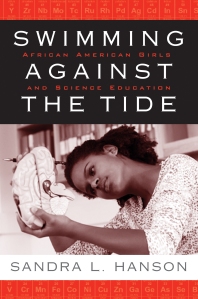Sandra Hanson, author of Swimming Against the Tide explains that African American women are interested in Science, Technology, Engineering, and Math.
A recent publication (in Cultural Diversity and Ethnic Minority Psychology) by a group of psychologists found that race and gender intersect in understanding Science, Technology, Engineering and Math (STEM) attitudes and participation. The research team was headed by Laurie T. O’Brien and focused especially on African American women. The researchers and subsequent media reports on the findings (e.g. in Inside Higher Ed and The Chronicle of Higher Education) expressed surprise at the high interest and participation in STEM among African American women. Several decades ago I began doing research on African American women in STEM funded by the National Science Foundation (NSF). Although some researchers have not focused on the way that race/ethnicity and gender interact to affect STEM experiences we have known for some time that we can expect the unexpected when it comes to African American girls and women in STEM. Some have argued that because women do less well in STEM and minorities do less well in STEM, there will be a double disadvantage for African American women.
 The argument of double jeopardy sees race and gender as additive. My findings from a representative sample of young African American women (published in a number of journal articles and in my book, Swimming Against the Tide: African American Girls and Science Education) suggested otherwise. Quantitative data from my sample and larger NSF surveys as well as open-ended questions and responses to vignettes were critical in measuring the young women’s experiences. They loved science. The young African American women signed up for science classes, loved doing experiments, went to science camp, and had posters of scientists on their walls. One young woman said that “science was like opening up a present from your favorite aunt.” My findings provided considerable evidence for the African American family and community as key in understanding this love of science. African American families have always made considerable investment in and had high educational and occupational expectations for their daughters.
The argument of double jeopardy sees race and gender as additive. My findings from a representative sample of young African American women (published in a number of journal articles and in my book, Swimming Against the Tide: African American Girls and Science Education) suggested otherwise. Quantitative data from my sample and larger NSF surveys as well as open-ended questions and responses to vignettes were critical in measuring the young women’s experiences. They loved science. The young African American women signed up for science classes, loved doing experiments, went to science camp, and had posters of scientists on their walls. One young woman said that “science was like opening up a present from your favorite aunt.” My findings provided considerable evidence for the African American family and community as key in understanding this love of science. African American families have always made considerable investment in and had high educational and occupational expectations for their daughters.
African American women have historically combined work and family roles. The answer to young African American women’s high level of interest and participation in STEM does not come from schools and teachers. In fact, the young women in my sample experienced considerable difficulty in the STEM classroom. One young girl reflected the opinion of many when she described the attitude of science teachers –“They looked at us like we weren’t supposed to be scientists.” The young women reported not being called on in the classroom and not being chosen as lab partners. Somehow, in spite of the chilly classroom climate, a disproportionate number of African American women manage to “swim against the tide” and persevere in STEM education and occupations.
Data from NSF show that African American women persist in many areas of STEM at a higher rate than do white women. My recent research on the male dominated area of engineering shows that even here African American women earn the largest share of doctorates relative to men (when looking within race/ethnic groups). In my testimony to the U.S Congress (Subcommittee on Girls in Science) I suggested that we need better teachers, science classrooms, and science textbooks. When young African American women look around them and see white teachers and white scientists in the science textbooks, they do not feel welcome. The considerable agency that African American women show in the context of a white, male STEM culture is encouraging. One can only imagine the increased number of talented African American women who would participate in STEM education and occupations in a more welcoming climate. The major science organization in the U.S. – the National Science Foundation – has recognized the problem and is funding a good number of programs to encourage minorities and minority women in STEM. After all, diversity in science makes for better science.
Filed under: african american studies, Education, gender studies, sociology, women's studies | Tagged: african american, Education, engineering, mathematics, science, sociology, technology, women |




Leave a comment